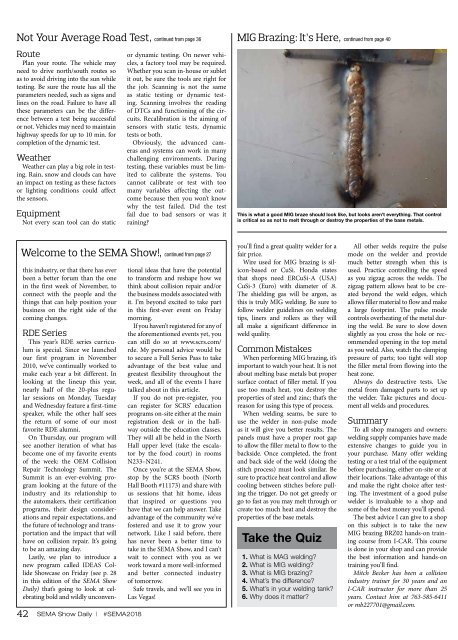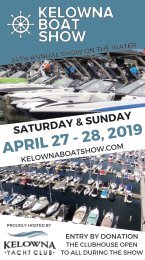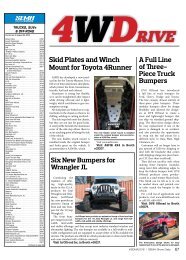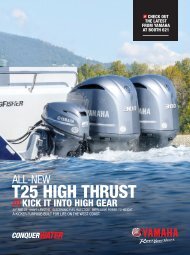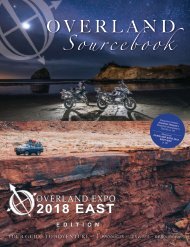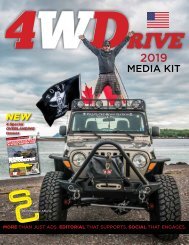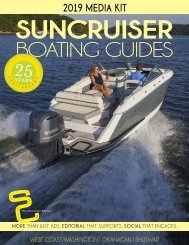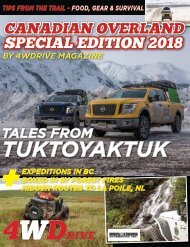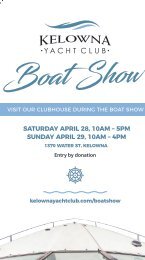Sema Show Daily 2018
You also want an ePaper? Increase the reach of your titles
YUMPU automatically turns print PDFs into web optimized ePapers that Google loves.
Not Your Average Road Test, continued from page 36<br />
Route<br />
Plan your route. The vehicle may<br />
need to drive north/south routes so<br />
as to avoid driving into the sun while<br />
testing. Be sure the route has all the<br />
parameters needed, such as signs and<br />
lines on the road. Failure to have all<br />
these parameters can be the difference<br />
between a test being successful<br />
or not. Vehicles may need to maintain<br />
highway speeds for up to 10 min. for<br />
completion of the dynamic test.<br />
Weather<br />
Weather can play a big role in testing.<br />
Rain, snow and clouds can have<br />
an impact on testing as these factors<br />
or lighting conditions could affect<br />
the sensors.<br />
Equipment<br />
Not every scan tool can do static<br />
or dynamic testing. On newer vehicles,<br />
a factory tool may be required.<br />
Whether you scan in-house or sublet<br />
it out, be sure the tools are right for<br />
the job. Scanning is not the same<br />
as static testing or dynamic testing.<br />
Scanning involves the reading<br />
of DTCs and functioning of the circuits.<br />
Recalibration is the aiming of<br />
sensors with static tests, dynamic<br />
tests or both.<br />
Obviously, the advanced cameras<br />
and systems can work in many<br />
challenging environments. During<br />
testing, these variables must be limited<br />
to calibrate the systems. You<br />
cannot calibrate or test with too<br />
many variables affecting the outcome<br />
because then you won’t know<br />
why the test failed. Did the test<br />
fail due to bad sensors or was it<br />
raining?<br />
MIG Brazing: It’s Here, continued from page 40<br />
This is what a good MIG braze should look like, but looks aren’t everything. That control<br />
is critical so as not to melt through or destroy the properties of the base metals.<br />
Welcome to the SEMA <strong>Show</strong>!, continued from page 27<br />
this industry, or that there has ever<br />
been a better forum than the one<br />
in the first week of November, to<br />
connect with the people and the<br />
things that can help position your<br />
business on the right side of the<br />
coming changes.<br />
42 SEMA <strong>Show</strong> <strong>Daily</strong> | #SEMA<strong>2018</strong><br />
RDE Series<br />
This year’s RDE series curriculum<br />
is special. Since we launched<br />
our first program in November<br />
2010, we’ve continually worked to<br />
make each year a bit different. In<br />
looking at the lineup this year,<br />
nearly half of the 20-plus regular<br />
sessions on Monday, Tuesday<br />
and Wednesday feature a first-time<br />
speaker, while the other half sees<br />
the return of some of our most<br />
favorite RDE alumni.<br />
On Thursday, our program will<br />
see another iteration of what has<br />
become one of my favorite events<br />
of the week: the OEM Collision<br />
Repair Technology Summit. The<br />
Summit is an ever-evolving program<br />
looking at the future of the<br />
industry and its relationship to<br />
the automakers, their certification<br />
programs, their design considerations<br />
and repair expectations, and<br />
the future of technology and transportation<br />
and the impact that will<br />
have on collision repair. It’s going<br />
to be an amazing day.<br />
Lastly, we plan to introduce a<br />
new program called IDEAS Collide<br />
<strong>Show</strong>case on Friday (see p. 28<br />
in this edition of the SEMA <strong>Show</strong><br />
<strong>Daily</strong>) that’s going to look at celebrating<br />
bold and wildly unconventional<br />
ideas that have the potential<br />
to transform and reshape how we<br />
think about collision repair and/or<br />
the business models associated with<br />
it. I’m beyond excited to take part<br />
in this first-ever event on Friday<br />
morning.<br />
If you haven’t registered for any of<br />
the aforementioned events yet, you<br />
can still do so at www.scrs.com/<br />
rde. My personal advice would be<br />
to secure a Full Series Pass to take<br />
advantage of the best value and<br />
greatest flexibility throughout the<br />
week, and all of the events I have<br />
talked about in this article.<br />
If you do not pre-register, you<br />
can register for SCRS’ education<br />
programs on-site either at the main<br />
registration desk or in the hallway<br />
outside the education classes.<br />
They will all be held in the North<br />
Hall upper level (take the escalator<br />
by the food court) in rooms<br />
N233–N241.<br />
Once you’re at the SEMA <strong>Show</strong>,<br />
stop by the SCRS booth (North<br />
Hall Booth #11173) and share with<br />
us sessions that hit home, ideas<br />
that inspired or questions you<br />
have that we can help answer. Take<br />
advantage of the community we’ve<br />
fostered and use it to grow your<br />
network. Like I said before, there<br />
has never been a better time to<br />
take in the SEMA <strong>Show</strong>, and I can’t<br />
wait to connect with you as we<br />
work toward a more well-informed<br />
and better connected industry<br />
of tomorrow.<br />
Safe travels, and we’ll see you in<br />
Las Vegas!<br />
you’ll find a great quality welder for a<br />
fair price.<br />
Wire used for MIG brazing is silicon-based<br />
or CuSi. Honda states<br />
that shops need ERCuSi-A (USA)<br />
CuSi-3 (Euro) with diameter of .8.<br />
The shielding gas will be argon, as<br />
this is truly MIG welding. Be sure to<br />
follow welder guidelines on welding<br />
tips, liners and rollers as they will<br />
all make a significant difference in<br />
weld quality.<br />
Common Mistakes<br />
When performing MIG brazing, it’s<br />
important to watch your heat. It is not<br />
about melting base metals but proper<br />
surface contact of filler metal. If you<br />
use too much heat, you destroy the<br />
properties of steel and zinc; that’s the<br />
reason for using this type of process.<br />
When welding seams, be sure to<br />
use the welder in non-pulse mode<br />
as it will give you better results. The<br />
panels must have a proper root gap<br />
to allow the filler metal to flow to the<br />
backside. Once completed, the front<br />
and back side of the weld (doing the<br />
stitch process) must look similar. Be<br />
sure to practice heat control and allow<br />
cooling between stitches before pulling<br />
the trigger. Do not get greedy or<br />
go to fast as you may melt through or<br />
create too much heat and destroy the<br />
properties of the base metals.<br />
Take the Quiz<br />
1. What is MAG welding?<br />
2. What is MIG welding?<br />
3. What is MIG brazing?<br />
4. What’s the difference?<br />
5. What’s in your welding tank?<br />
6. Why does it matter?<br />
All other welds require the pulse<br />
mode on the welder and provide<br />
much better strength when this is<br />
used. Practice controlling the speed<br />
as you zigzag across the welds. The<br />
zigzag pattern allows heat to be created<br />
beyond the weld edges, which<br />
allows filler material to flow and make<br />
a large footprint. The pulse mode<br />
controls overheating of the metal during<br />
the weld. Be sure to slow down<br />
slightly as you cross the hole or recommended<br />
opening in the top metal<br />
as you weld. Also, watch the clamping<br />
pressure of parts; too tight will stop<br />
the filler metal from flowing into the<br />
heat zone.<br />
Always do destructive tests. Use<br />
metal from damaged parts to set up<br />
the welder. Take pictures and document<br />
all welds and procedures.<br />
Summary<br />
To all shop managers and owners:<br />
welding supply companies have made<br />
extensive changes to guide you in<br />
your purchase. Many offer welding<br />
testing or a test trial of the equipment<br />
before purchasing, either on-site or at<br />
their locations. Take advantage of this<br />
and make the right choice after testing.<br />
The investment of a good pulse<br />
welder is invaluable to a shop and<br />
some of the best money you’ll spend.<br />
The best advice I can give to a shop<br />
on this subject is to take the new<br />
MIG brazing BRZ02 hands-on training<br />
course from I-CAR. This course<br />
is done in your shop and can provide<br />
the best information and hands-on<br />
training you’ll find.<br />
Mitch Becker has been a collision<br />
industry trainer for 30 years and an<br />
I-CAR instructor for more than 25<br />
years. Contact him at 763-585-6411<br />
or mb227701@gmail.com.


